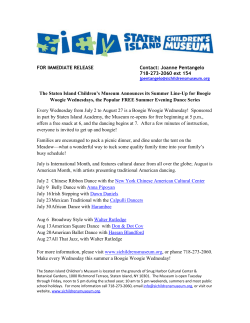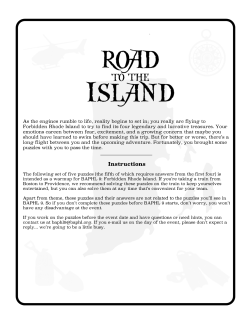
Document 243022
Irving, RA, Schofield, AJ and Webster, CJ. Island Studies (1997). Bideford: Lundy Field Society Why Study Islands? John Schofield and Jennifer J George Be not ajeard: the isle is full of noises, Sounds and sweet airs, that give delight and hurt not. (William Shakespeare: The Tempest) true islands, perhaps following the construction of bridges. Yet, despite the size range, and scale of their separation or isolation, most islands have something distinct about their ecology and the terrestrial communities they support. In this contribution, we will consider this background, providing a selection of the better known examples of island research by way of illustration. The character of islands Introduction Islands have, for centuries, had a particular attraction, whether for achieving strategic objectives in a military campaign, for creative inspiration in literature and the arts, or for attaining personal contentment. They also have a significant role in both cultural history and the history of science. But when we think in these terms, we tend to visualise a particular type of place: small, isolated islands with sandy beaches backing onto woodland, and a rich flora and diverse fauna thriving under a hot equatorial sun. It is as well to emphasise the obvious: that not every island is such a paradise. Some islands are barren and inhospitable places; some are so large as to not have the feel of islands at all. Clearly the degree of islands' separation, and their size , vary considerably, while their position on the globe largely determines the nature of their ecology. Some islands are new, emerging in comparatively recent times as volcanoes, and some cease to exist as Islands, and the opportunities they provide for seclusion and retreat, seem to have a particular poignance in the modern high tech world of the mobile phone and the World Wide Web (but it is interesting to note that the small communities on Shetland are now using the Internet to protect their sense of community [Spinney 1995]). That islands had similar appeal in the past is well recorded, with terms like 'magical' and 'irresistible' being frequently used in contemporary accounts and literature. Examples include the quotation from The Tempest, presented at the start of this chapter. In the context of Lundy, a similar message is conveyed by Felix Gade in a quotation from his autobiography: "... In spite of the comparative primitiveness, inadequacy and even hardship of living on a very small, remote, windswept island, there is some indefinable attraction about such a place which lures one back... Sometimes I think it is purely and simply the Copyright (1997) Lundy Field Society and the author Irving, RA, Schofield, AJ and Webster, CJ. Island Studies (1997). Bideford: Lundy Field Society WHY STUDY ISLANDS? 6 peace and quiet, which exists even when t he elements are at their worst; or it may be the sense of freedom, the independence, the absence of the minor tyrannies Q[ life in a large community; or it may be the challenge of wringing a livelihood on this bleak outpost in spite of the storm and tempest, drought and deluge. Then again, it could be that one's entity is more apparent amongst a small island community. Every single person has an importance, an individuality. Finally there is the island itself, which ingrains itself into one's very marrow; the beauty, the grandeur, the endurance, the solitude ... " (1978, 16). A theme often presented in literary works is the formative effect of being marooned, and, as is well documented in fact and fiction, this cuts both ways - good in some cases, ill in others. The first of this genre was Robinson Crusoe, published in 1719, about a man shipwrecked on a desert island for 28 years. The possible effects of such isolation are discussed more fully below. The seclusion islands provide also contributes to their appeal as natural research laboratories, the physical boundary acting as a constraint on regular movement. As is discussed elsewhere (Schofield in press), this seclusion or separation provides islands with certain characteristics, rendering them distinct from other types of location. First, there are the associated properties of security versus isolation, limitation of resources versus abundant availability of certain island products, and the sea as a barrier versus the sea as a means of communication (Blache 1950). Then there are the characteristics which make them units "that the mind can pick out and begin to comprehend" (MacArthur and Wilson 1967,3): relative isolation, limitation in space, limitation in or absence of resources, limitation in organic diversity, reduced interspecies competition, protection from outside competition (Fosberg 1965,5). However, to use 'anything with all of the above' as a definition risks oversimplification. In this sense , a quotation from D.H. Lawrence's short story The Man Who Loved Islands, first published in 192 7, is useful in defining what, in terms of locations suited to the kinds of scientific research addressed in this volume, we mean by island: "An island, if it is big enough, is no better than a continent. It has to be really quite small before it feels like an island". Island studies As this contribution will demonstrate, islands of the type described above have been the subject of many aspects of research since at least the mid 19th century, and many individual islands are well known as a result; the Galapagos archipelago and finches for example are synonymous, as are Easter Island and the maoi, or giant statues. Many islands, however, less well known in their own right, have seen significant data collected which have contributed to broader research themes, such as the role of bird observatories in understanding migration; alternatively there are Copyright (1997) Lundy Field Society and the author Irving, RA, Schofield, AJ and Webster, CJ. Island Studies (1997). Bideford: Lundy Field Society ISLAND STUDIES 7 islands where research covering many disciplines is constantly underway, gradually changing our perceptions of animal or human behaviour, evolution and so on. Since the Lundy Field Society was founded in 1946, and through to around the mid 1950s, Lundy saw an emphasis on bird observation, not surprisingly given its origins. However, this has changed in more recent years, arguably from around 1956 (see Webster, this volume), since when a greater diversity of research has been undertaken. Some aspects of this research involve topics which are of considerable interest and worth, but for which Lundy's island status is of less relevance; others require islands to such an extent that other types of location will be unsuitable. As the papers in thiS volume make clear, the cumulative results of fifty years of research on Lundy, building to some extent on previous work, has made a significant contribution to our understanding of many specific aspects of what come under the very general headings of ecology, and the history of human occupation. Important research has also been undertaken in other fields such as geology, and these are covered elsewhere in the volume. Here, we review just two of the main themes which make island research important, and which provide a framework within which the achievements of the Lundy Field Society, 1946-1996, can be better understood: evolutionary ecology and human occupation and adaptation. Evolutionary ecology Charles Darwin, at the beginning of his career, wrote: "The zoology of archipelagoes will be well worth examination". How true this was. From his observations and those of Alfred Russel Wallace in his studies of islands on the archipelago between Southeast Asia and Australia, the modern theory of evolution was born. Both men were developing similar ideas on the origin of different species, but it was Darwin who in 1858 published his theory of Natural Selection that is now accepted by scientists. Simply, the theory says that a pair of animals or plants produce many more offspring than are needed to replace them, and that these offspring are not identical with one another; some are better fitted for survival than others, and these will have an advantage in the competition that occurs for food and shelter, finding a mate and so on. They will therefore survive and reproduce, and their favourable characteristics will pass into the next generation. If a species becomes isolated, as occurs on an island, then the gene pool of a population can become different from a similar population on the mainland and eventually a new species may evolve. These species are unlikely to leave the island habitat because of the surrounding ocean, and consequently, will not occur elsewhere in the world. Such species are said to be endemic to that island. The study of the flora and fauna of islands provides an understanding not only of the process of evolution, Copyright (1997) Lundy Field Society and the author 8 Irving, RA, Schofield, AJ and Webster, CJ. Island Studies (1997). Bideford: Lundy Field Society \VHYSTUDYISLANDS? but also an insight into how organisms colonise an island from the mainland, and subsequent adaptation of these organisms to a new and often different environment. Also, factors such as the numbers of organisms that can be supported on an island and the rate of extinction of a species can be quantified, and the development of the island flora and fauna into an integrated self-sustaining ecosystem can be studied. The emergence of an island from the ocean, such as Surtsey in the Atlantic in 1965, provides a unique opportunity for research into the development of animal and plant communities. The very existence of a species on an island provides knowledge of colonisation and dispersal patterns. Oceans are effective barriers to distribution, except of course to birds and flying insects. However, some land animals may arrive on rafts of drifting debris, while the seeds and spores of plants can be carried by wind or travel attached to the bodies of birds and large insects. For example, it is thought that 60% of the indigenous flora of the Galapagos islands were brought in by birds, 30% by the wind, and 10% drifted in by sea. On large islands there is a tendency for plants and animals to lose the dispersal mechanism that brought them to the island in the first place; for example, plant seeds often lose their feathery tufts, insects become wingless, and birds have become flightless over a period of time. Examples include the kiwi of New Zealand and the dodo of Mauritius (now made extinct by man). The absence of predatory species on islands is often a contributing factor to this phenomenon. Isolation is a major factor influencing the development of species on an island. As a result, islands have a high proportion of endemic forms. On the Galapagos islands about 34% of the terrestrial plants, 50% of the terrestrial animals and 25% of the marine flora and fauna surrounding the island are endemic. In the Hawaiian islands in the middle of the North Pacific ocean, over 90% of the flora are endemic. If islands are situated a long way from a continent, then often many groups of plants and animals may be absent; for example, on the Hawaiian islands there are no freshwater fish, no native amphibia, reptiles and mammals, except for one species of bat. For an animal or plant to survive on an island it must be able to adapt to different conditions. A species that can utilise many kinds of food is therefore at an advantage, and a well-known example of such adaptive radiation is that of the finch population on the Galapagos islands (Weiner 1995). There are now thirteen different species of finch present, feeding on a variety of food - seeds, nuts, fruit, flowers and insects. On the mainland these niches are occupied by different bird species, but on the Galapagos the different finch species probably evolved from a seed-eating ancestor and were able to adapt to different ways of life due to lack of competition from other birds. Another example can be found on the HawaHan islands where members of the plant family Lobeliaceae have undergone extensive adaptive radiation (Carlquist Copyright (1997) Lundy Field Society and the author Irving, RA, Schofield, AJ and Webster, CJ. Island Studies (1997). Bideford: Lundy Field Society ISLAND STUDIES 9 1965). There are now 150 species and varieties of lobeliads ranging from erect tree forms 9m tall to small soft-stemmed species. Linked to adaptive radiation of the lobeliads is the evolution of the nectar feeding bird, the honey-creeper (family Drepanididae), that has eleven endemic genera in the family, species of which now also feed on insects, seeds and nuts as well as plant nectar (Amadon 1950). Life on islands is more hazardous than on the mainland. Islands, with their smaller and less diverse communities, are less stable than the mainland, and consequently are much more susceptible to environmental change. Furthermore, severe weather or catastrophe such as a volcanic eruption can cause species to become extinct; and there is little chance of the species returning to colonise when good conditions return as often happens on the mainland. Islands and their ecology are thus of considerable importance in our understanding of biological processes and how life develops and functions. They provide a unique opportunity to study evolution as their isolation provides the ideal environment for rapid population change and adaptive radiation that cannot be seen so clearly on the mainland. The small-scale studies that can be attempted on islands often provide valuable information that can be used to interpret community and population structure on the larger continents. Human occupation and adaptation In a paper, now over twenty years old, the advantage of using islands as laboratories in the study of human cultural development, was explored by John Evans (1973). Amongst other things he noted the fact that natural scientists, arguably beginning with Charles Darwin, and anthropologists, such as Margaret Mead, were among the first to recognise their potential in these terms, and that archaeologists had been relatively slow to follow on. As with non-human populations, island life imposes restrictions on communication with groups living elsewhere, and this isolation makes it possible to study their development over long periods, unaffected by radical interference from outside. Two aspects of island research into human populations are considered here: first, islands can be used to study colonisation, the processes involved, the population size required for successful colonisation, and the likelihood of survival (adaptation, in other words); second, islands provide the opportunity for studying the tendency isolated communities have towards exaggerated development in some aspects of their culture. Colonisation, and the minimum size of population required for this to be successful, was addressed by Stephen Black in 1978. Taking Polynesia as his study area, he used a computer simulation to assess the probability of success of small founding populations, concluding that a mixed group of ten individuals could survive under ordinary circumstances. In short, a Copyright (1997) Lundy Field Society and the author 10 Irving, RA, Schofield, AJ and Webster, CJ. Island Studies (1997). Bideford: Lundy Field Society \VHYSTUDYISLANDS? canoe-load of voyagers may be sufficient for a successful colonisation (Black 1978,66). even taking into account the potentially damaging effects of inbreeding. This finding however appears to contradict the reality of life on both Pitcairn and Henderson, also in Polynesia, where Marshall Weisler's (1994) fieldwork has provided insights into human group dynamics with its portrait of a tiny population dying out under the social equivalent of solitary confinement. In both cases the populations, c.50 in the case of Henderson, hundreds on Pitcairn, died out at around AD 1600 following around 500 years of continuous occupation. As Weisler suggests, eventually no marriage partners could have remained who did not violate incest taboos, while the effects of inbreeding may have appeared before that. Another possibility might have been a climatic fluctuation driving the islanders to starvation. The population may equally have responded to the threat of extinction by murder and cannibalism, as is thought likely with California's Donner Party of pioneers (Grayson 1990). Or the islanders may have become insane from social deprivation, as happened to a Belgian Antarctic Expedition trapped by ice for over a year. These are examples where populations failed to . adapt under conditions of duress, specifically isolation. But isolation can have a positive effect in some cases. It can, as John Evans suggested in his 1973 paper, promote exaggerated development of some aspect of an island's culture. This is often ceremonial in nature, and the Easter Island maoi come into this category. It is also tempting to suggest the megalithic monuments of Orkney, and perhaps even the spectacular cliff castles of the Aran Islands as representatives of this exaggerated development. The study of these monuments, and of the communities who built them, will tell us how this process developed, when the exaggeration occurred, and why. In the case of the maoi, was it to 'advertise' the insularity of the island's communities, or was the sheer number of monuments indicative more of the competition which existed between island families or communities? But this physical manifestation may take another form: literature. On the Blaskets and the Aran Islands, off the south-west and west coasts of Ireland respectively, communities in the early twentieth century began to write down what had previously been passed by word-of-mouth: a wealth of folk tales, poems and songs reflective of their history and lifestyle over generations (Schofield in press), seemingly out of proportion to the size of community from which they derived. Works of a narrative anecdotal nature are particularly useful in telling us about the way of life among island communities before the advent of modern technology and communication. This is as close as we come to a direct ethnographic analogy for the prehistoric and early historic occupation of small islands. The works tell us about social organisation and politics, how decisions were made; they tell us about ordinary daily events, such as fishing trips, seal hunts, kelp gathering; they tell us about the hardships Copyright (1997) Lundy Field Society and the author Irving, RA, Schofield, AJ and Webster, CJ. Island Studies (1997). Bideford: Lundy Field Society ISLAND STUDIES II of island life and the advantages of sometimes being "a world apart", such as during the time of the Great War. But the question remains, is this degree of creative achievement unusual? If so, why does isolation have this effect, and, assuming that it is not inevitable, under what circumstances might it arise? There are various possibilities: maybe it is the fact that "every single person has an importance, an individuality" (Gade 1978,16) and thus something to contribute. Or maybe it is as Rogers (1978,x) has suggested: "where life in general is limited and monotonous, its least detail is exalted into Drama: islanders who live in the shapeless shadow of poverty will always put a pattern of dignity and ceremony on it, in order to endure and redeem their existence" . Literature, such as that described here, is but one manifestation of the exaggerated development witnessed amongst some isolated communities. It also constitutes a cultural resource of immense importance in understanding how island communities survived, as well as documenting their decline (the Blaskets were finally abandoned in 1954). At the end of Tomas O'Crohan's book, The Islandman, first published in 1937, his perceptive remarks betray his awareness of the inevitable, but also demonstrate his knowledge that by writing down what was previously passed by word-of-mouth, he had done those who follow a great service: "One day there will be none left in the Blasket of all I have mentioned in this book,and none to remember them. I am thankful to God, who has given me the chance to preserve from forgetfulness those days which I have seen with my own eyes and have borne their burden, and that when I am gone, men will know what life was like in my time, and the neighbours that lived with me" (O'Crohan 1992,244). Islands therefore have a particular part to play in understanding human occupation and adaptation, and that is reflected in the amount of research undertaken on islands around the world in recent years. Some sceptics continue to interpret this more in terms of the pleasant working conditions that islands provide; but there is a real significance in scientific terms, as the examples presented above demonstrate. Conclusion What we have presented in this contribution is nothing more than a background against which to place the papers which follow. Our intention has been to outline the significance islands have in scientific research generally, and to demonstrate the potential they have to address questions which are often either best addressed, or can only be addressed, by studying islands. As we have said before, Lundy has been the subject of research covering a wide range of disciplines over Copyright (1997) Lundy Field Society and the author Irving, RA, Schofield, AJ and Webster, CJ. Island Studies (1997). Bideford: Lundy Field Society \VHYSTUDYISLANDS? 12 many years, and this has been supported and, in many instances, undertaken by members of the Lundy Field Society. As well as providing some new insights into Lundy's history, the contributors to this volume have been asked to illustrate the range of work undertaken, the significance of the results within their subject generally, as well as providing an illustration of changing methods and objectives over a fifty year period. We think Lundy has a significance in these terms which justifies this treatment at the time of the Field Society's fiftieth anniversary; the papers presented provide the opportunity for you, the reader, to reach your own conclusion. Copyright (1997) Lundy Field Society and the author Irving, RA, Schofield, AJ and Webster, CJ. Island Studies (1997). Bideford: Lundy Field Society ISLAND STUDIES 13 References Amadon, D, 1950. The Hawaiian honey-creepers. Bulletin of the American Museum of Natural History 95, 15 1-262 . Blache, J, 1950. Les particularites geographiques des iles . Bulletin de La Societe de Geographie de Marseille 65, 5-22. Black, S, 1978. Polynesian outliers: a study in the survival of small populations. In I Hodder (ed), Simulation studies in archaeology, 63-76. Cambridge University Press. Carlquist, S, 1965. Is land Life. New York: Natural History Press. Evans, J D, 1973. Islands a s laboratories for the study of culture process. In A C Renfrew (ed), The Explanation of Culture Change: Models in Prehistory, 517-20. London: Duckworth. Fosberg, F R, 1965. The island ecosystem. In F R Fosberg (ed), Man's place in the island ecosystem, 1-6. Honolulu: Bishop Museum Press. Gade, F, 1978. My Life on Lundy. Privately published. Grayson, D, 1990. Donner Party deaths: a demographic assessment. Journal of Anthropological Research 46, 223-242. MacArthur, R J , & Wilson, E 0, 1967. The theory of island biogeography. Princetown University Press. O'Crohan, T, 1992. The Islandman. Oxford University Press. (Originally published by the Talbot Press, Dublin, 1937.) Rogers, W R, 1978. Introduction to Sayers P, An Old Woman's Reflections. Oxford University Press. Schofield, A J, in press. Exploring insularity: some thoughts on island archaeology. In M Patton and K Brown (eds), Island Archaeology. British Archaeology Reports. Spinney, L, 1995. Electronic crafting. New Scientist 147, 30-33. Weiner, J, 1995. The Beak of the Finch: A story of evolution in our time. Vintage. Weisler, M, 1994. The settlement of marginal Polynesia: new evidence from Henderson Island. Journal of Field Archaeology 21, 83-102. Copyright (1997) Lundy Field Society and the author Irving, RA, Schofield, AJ and Webster, CJ. Island Studies (1997). Bideford: Lundy Field Society Copyright (1997) Lundy Field Society and the author
© Copyright 2025









